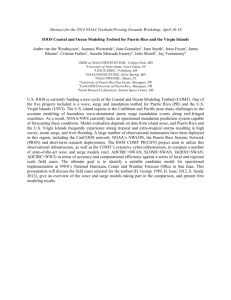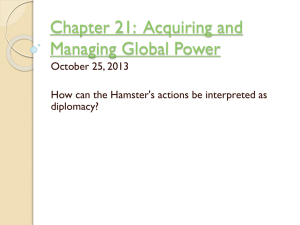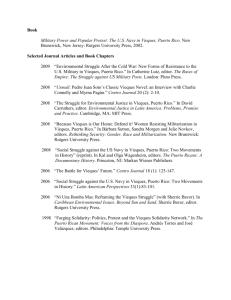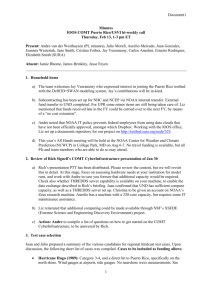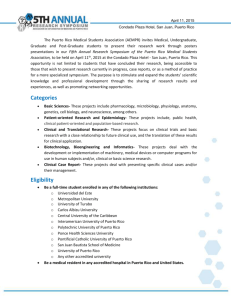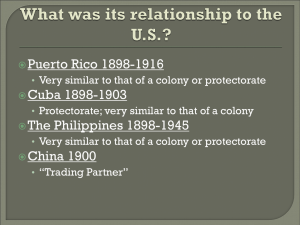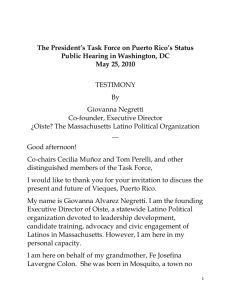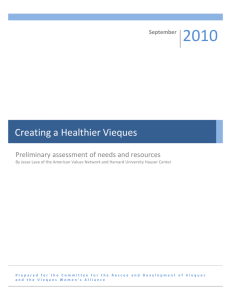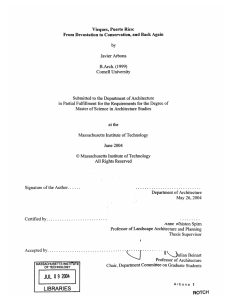Puerto Rico, Old and New
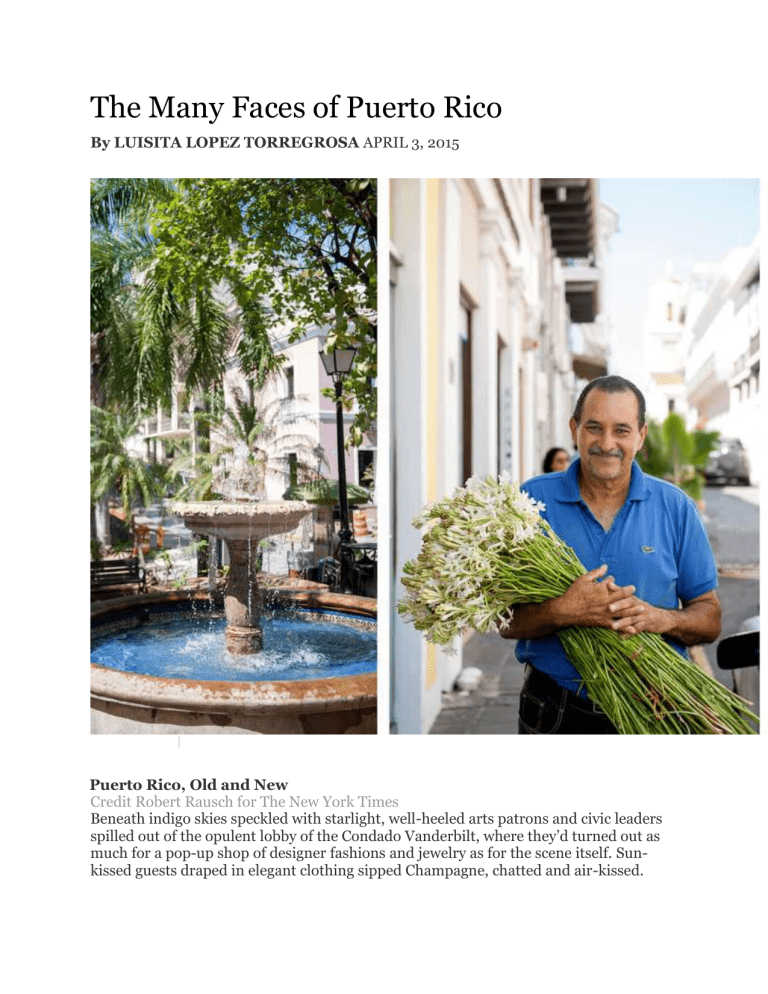
The Many Faces of Puerto Rico
By LUISITA LOPEZ TORREGROSA APRIL 3, 2015
SLIDE SHOW | 1 1 PH OT O S
Puerto Rico, Old and New
Puerto Rico, Old and New
Credit Robert Rausch for The New York Times
Beneath indigo skies speckled with starlight, well-heeled arts patrons and civic leaders spilled out of the opulent lobby of the Condado Vanderbilt, where they’d turned out as much for a pop-up shop of designer fashions and jewelry as for the scene itself. Sunkissed guests draped in elegant clothing sipped Champagne, chatted and air-kissed.
The hotel, a newly restored palatial resort with a legendary pedigree dating to 1919, had just reopened to much fanfare, and it seemed poised to once again become the epicenter of refined San Juan social life. As I surveyed the crowd, I was transported to my own past, when girls like me swanned at debutante parties in grand ballrooms and women like my mother attended fashion shows in hats and gloves.
Later that same night, a mere 20 minutes away, I attended a different sort of opening, at
La Productora, where the excitement was rooted in the promise of the future rather than the glamour of the past.
At this gallery, in a former warehouse on a side street in a dodgy neighborhood of lowcost houses and cut-rate shops, the crowd was in their 20s and early 30s, and the drink of choice was Medalla Light. Upstairs, in four high-ceilinged rooms crammed with paint cans, brushes, tools and screens, a smattering of pieces were hung and others simply leaned against the walls. Asked why he had chosen this space, the gallery owner, Martín
Albarrán, said, “Why here? One reason, cheap rent.”
Photo
The Casa Cortés art gallery.
These two openings exemplify the variegated landscape that visitors to Puerto Rico can expect when they touch down nowadays. The commonwealth has in recent years been seeking to replace spring breakers and middlebrow clientele with a high-end set, enticing them with newly restored resorts and restaurants with hot chefs in San Juan and Vieques, too. It has embraced its faded former glory at the same time as it has supported an upstart artistic community that somehow is thriving just beyond the historic, museumlike center of Old San Juan.
But can Puerto Rico be a Bushwick, Brooklyn, by the sea, a Palm Springs set in the tropics and a preserver of Spanish colonial architecture all at the same time? That seems to be its aim, and perhaps it’s only natural that a place that has been trying to redefine its status and relationship with the United States for more than a century would offer a shifting identity, seeking to be all things to all comers. It’s in permanent limbo, too farflung to feel American and yet too familiar to feel like a different country.
Whatever Puerto Rico has become, I saw signs on my trip there this winter that being too complicated to label had revitalized it. Old, new, colonial, anti-establishment — traveling through the islands was like attending a cocktail party with a very eclectic guest list. Murals on underpasses gave way to glistening hotel towers, which gave way to the rustic beaches of Vieques.
I’d gone there to see what had become of a homeland I’d left at 14 and returned to only sporadically, in time to see the cosmopolitan surge that eventually soured after the recession of 2007, when rampant crime pervaded previously upscale areas.
I wouldn’t find an easy answer. Now, Puerto Rico is perhaps more difficult to pin down than destinations of a similar size — the archipelago that includes the island for which the commonwealth is named has a land mass smaller than Connecticut’s — but it seemed more self-assured than it has been in a long time. That much was clear from the moment I arrived, and I couldn’t wait to see more.
The main cultural asset associated with Puerto Rico has long been music. Spain lost the islands in the 1890s, rather late in the colonial scramble for the Caribbean, and as a result Puerto Rico has retained a Latin-infused language and heritage, evident in music ranging from bomba to salsa to reggaeton.
Now, though, it has become home to a thriving visual arts community.
La Productora, for example, is part of a Calle Cerra collaborative, a group of young aspiring artists and gallerists. But a similar conversion is happening on Calle Loíza, a potholed commercial artery full of abandoned buildings, gas stations and old-time beauty parlors. They are being joined by quirky bars, modish specialty shops and galleries. At night, Sanjuaneros hop from Funky Buddha and Bar Bero, to the Art d’Chocolat, to the Argentine bodega Agarrate Catalina and spots like the inexpensive outdoor Café Tresbe, the pizza and whiskey bar Loiza 2050. Other formerly sleepy areas of town are gentrifying. A new design district anchored by the Walter Otero
Contemporary Gallery is springing up off Avenida Constitución, breathing new life into a marginal industrial area.
Photo
The guard post at Puerta de San Juan entrance. CreditRobert Rausch for The New York
Times
This is not by happenstance. With government and private backing, graffiti artists and muralists who operate under names like the all-female Morivivi collective and Bikismo, a solo muralist who exhibited work at Miami’s Art Basel in 2014, have become celebrities there.
“It’s a new manifestation of art,” Ninah Aymat, a Christie’s-trained assistant director at the Otero Gallery, told me. While collectives like Calle Cerra play a role, street art “is effervescent all across the island.” She doesn’t see it as a shift but as a “movement within the art world that’s more appealing and accessible to a diverse crowd.”
Street art has pretty much taken over congested Santurce, spilling over into nearby neighborhoods. There are no boundaries. Murals pop up along freeways, on cruddy streets, on abandoned storefronts, on old and new buildings, near hotels and on billboards.
The reclamation of these neighborhoods is all the more surprising because Puerto Rico, like so much of the Caribbean, seeks to hide its economic woes from visitors, presenting a glossy exterior rather than street art in run-down districts. It has a lot to paper over:
Puerto Rico is approximately $73 billion in debt, its debt rating has spiraled to junk
status, unemployment stands at 13.5 percent and thousands of professionals a year leave for rosier economic climes like Florida. The exodus of middle and upper-income professionals and blue-collar workers has drained some sectors (law, education, small businesses, health services) and deprived the island of badly needed tax revenues. High crime rates, heavy drug trafficking, corruption and government incompetence add to the bleak picture.
Yet mainland and foreign investors are taking advantage of financial opportunities and tax breaks, backing hoteliers who are opening lavish resorts, boutique hotels and restaurants. Some credit goes to a 2012 Puerto Rican law offering tax breaks to highincome mainland citizens who buy property in the commonwealth and move there.
Hundreds have taken up the offer so far. In addition to that perk, there are other incentives for investors in tourism. A government tourism promotional leaflet reads
“Sol, arena y cero impuestos,” “Sun, sand and zero taxes.”
It seems to be an easy sell. The Puerto Rican government has signed up a Virginia developer, Clark Realty Capital, to turn the 3,000-acre former Roosevelt Roads Naval
Station into a multibillion-dollar seaside residential-entertainment project with hotels, an airport, a marina and a harbor. The Roosevelt Roads project will be financed entirely by private investors, including Clark, an official of the redevelopment authority, Freddy de Jesús, wrote in an email. Though Clark has not received any tax incentives, it could apply for them after the master developer contract is signed. Clark estimates that the project would involve $3.2 billion investment over 30 years. The plan is expected to start by this summer. It is unique to the Caribbean because of the change in land use and the size of the project.
The project is part of the push to draw luxury clientele: celebrities, fashionistas, onepercenters, high-flying singles. Hotels are the main magnet, but high-end shopping like the new Mall of San Juan, near the international airport, is part of the mix. The man behind much of the effort to revitalize San Juan is the billionaire John Paulson, president of the New York-based investment firm Paulson & Co., who has a majority stake in the Condado Vanderbilt and in La Concha Hotel next door. Mr. Paulson poured
$260 million into the hotels in partnership with International Hospitality Enterprises, a major owner and operator of hotels on the island.
The industry hopes that super expensive coastal resorts like the St. Regis Bahia; the
Royal Isabela luxury golf course and resort; the Four Seasons, which is set to open in
2017; and the restored $1,799-a-night Dorado Beach Ritz-Carlton Reserve — where I played in the water slides and the roiling surf those many Sundays of my youth — will put Puerto Rico on par with glamorous St. Bart’s and Anguilla.
Photo
The dining room of La Mallorquina.
CreditRobert Rausch for The New York Times
It already has the cuisine to compete . A very vocal culinary vanguard seeks to resurrect
Puerto Rico’s past agrarian glory and transform the islands into a farm-to-table haven.
The chef of Le Bernardin, Eric Ripert, is an unabashed fan who credits the Puerto Rican chefs Alfredo Ayala, Wilo Benet, José Santaella and Mario Pagán as trailblazers who fused international and criollo dishes to create a contemporary Puerto Rican cuisine.
Some of the best food in Puerto Rico can be found these days at José Enrique, a modest pink casita a block from the nearly century-old farmers’ market Placita de Santurce, a neighborhood of produce and meat stands and down-home criollo bodegas. Named for its celebrated 37-year-old chef and owner, the restaurant has no sign, no set menu and takes no reservations. The dining room is set up with bare tables and a small bar, and the staff is friendly if harried, trotting plates to a festive and loud lunch-hour crowd of business people, lawyers, executives and tourists. On a white chalkboard is a simple one-or-two-word menu: mahi mahi, scallops, tuna and so on, with entree prices running up to $30.
I went there with my cousin Sigrid and her friend Marilyn, two lawyers who are José
Enrique veterans. They ordered nearly half the menu and a bottle of Spanish red.
Everything moved fast, plates landed on the table and flew off, each bite an exclamation of pure delight. Fried yellowtail snapper, perfectly grilled churrasco, avocado and papaya salad all came so quickly I couldn’t keep track of what I was eating. Two hours later, when the crowd dispersed and the restaurant went into siesta mode, we finished off a dish of coffee flan, a dessert my mother would’ve swooned over.
José Enrique, of course, has branched out, and has a restaurant in El Blok inn in
Vieques, the North Fork of Puerto Rico. After three days in busy metro San Juan, I took a bumpy 20-minute flight to the island on an aging eight-seater Cessna. But once I landed, I found an understated iteration of the capital’s luxurious digs paired with its madcap experimental artistic sensibility.
Vieques has gone from military testing site to Fantasy Island, with locals living simply, tourists lounging on sparsely populated beaches and wild horses grazing on lush farms.
Small planes land every day on the hour, flying in supplies, groceries and tourists from the Puerto Rican mainland seven miles away.
The taxi van that I took from the airport traveled a two-lane road of hairpin turns, passing horse stables and farms, brightly colored cinder block and wood-framed homes, new large houses on sloping lawns and hillside mansions fronting the sea. Many of those are owned or rented by seasonal visitors like the New Yorkers and New Englanders who make up a sizable number of Vieques regulars.
But no structure was more striking than El Blok, a new inn set back on a corner lot of the malecon in Esperanza, a seafront strip of quaint restaurants and stores. An exotic oddity with a round cast-iron and concrete facade, sculptural perforations and open floors, El Blok is so unusual I could hardly find the front door. Up a flight of stairs,
Justin, a friendly young manager wearing an El Blok T-shirt, offered to take me on a tour. He started by saying that El Blok, which opened in August 2014, is LEED-Gold certified. The rooms are furnished plainly, though in a concession to comfort, they do have flat-screen TVs. The second-floor communal lobby is open to wind, sun and rain and furnished in handmade wooden chairs and tables and a few works of art. Splashes of color and flowering greenery break the gray monotone of polished plaster.
Standing in the bar-restaurant area, El Blok’s co-owner, Simon Baeyertz, a dashing New
Zealander and longtime record industry executive, explained his reasoning for opening an upscale hotel there. Though he and his co-owners, all English, received tax credits from the Puerto Rican government as well as certain tax exemptions and other incentives, he later wrote in an email, that wasn’t the sole reason.
O L D
S A N J U A N
“After years staying in hotels, I figured I should be able to engineer a guest experience for intrepid travelers like me, and Vieques really shone as the place to do that,” he said.
“I do see El Blok as part of a young, cool and creative Puerto Rico that is making the country a far more interesting destination than it has been in the past.”
El Blok is not a pioneer here. The Hix Island House, a compound of loftlike guest rooms in four concrete buildings on a 13-acre wooded hillside built by the Canadian architect
John Hix, opened in 2001. He designed square and triangular shapes of reinforced
concrete with polished concrete floors and large unglazed cutouts to let in sunlight and wind and frame sea views. The outside of the buildings is left raw and the interior spare.
The rooms have no air-conditioning, no telephones, no TVs, and there’s no restaurant or shop on the grounds. Island House guests want to get off the grid, cook for themselves, read, write, watch the birds and sortie out to bistros, bars and cantinas in town.
Regulars come during the winter and head back to Cape Cod or Maine in summer. An informal survey done in 2014 by Bob Gevinski, the hotel manager, shows 90 percent of their guests come from the mainland United States, with 33 percent of that number coming from New York City, percentages that match overall tourist numbers in Vieques and in mainland Puerto Rico.
“We market ourselves as a honeymoon and couples hotel,” Mr. Gevinski said while showing me around. A former CBS marketing and advertising executive, he had an itch to live in the Caribbean and when the chance came, he grabbed it. “I signed up for two years and have turned it into seven.”
We slogged uphill to meet John Hix, now in his late 70s, and his designer wife, Neeva
Gayle. They’ve been coming to Vieques for decades and now split the year between
Vieques and Vancouver, British Columbia. Their home, though larger than guest rooms, exemplifies the style of Island House: bare, open, stark lines, unadorned facades, a quieter glamour than what you’d find back in San Juan. Nothing like it existed in the traditional Spanish and Mediterranean architecture of my childhood, least of all on
Vieques, which was a backwater none of us mainland Puerto Ricans cared to visit.
For me, no visit to Puerto Rico is complete without a walk up and down the steep cobblestone streets of Old San Juan, the 500-year-old Spanish colonial city that is
Puerto Rico’s heart. These days the old city is having a bit of a revival, too. Weathered two-story casas with ornate wooden balconies, high doors and shutters are getting new coats of paint in tropical blues and greens, yellows and pinks. Old-time coffee shops like
La Bombonera, where as a child I had countless puffy mallorca buns, were being rebuilt on the remnants of the 1902 original. A few streets down, La Mallorquina, built in 1848 and one of the first grown-up restaurants I’d gone to as a child, was back in business, replicating its 19th-century architecture and design, with tiled floors, high arches, an interior courtyard and a classic Spanish menu including asopao and paella that made going to the restaurant a memorable occasion for more than a century.
On a busy Friday at the start of the raucous San Sebastián fiestas, gawkers and partyers slowed me on my way to ChocoBar de Casa Cortés, a new restaurant for chocolate obsessives. It was early afternoon and there was hardly a seat available in the main room. Wallpaper murals picturing the Cortés family history loomed over a boisterous crowd of children and grown-ups. The restaurant’s general manager, Sergio Bevilacqua, and the Casa Cortés Foundation’s director, Adelisa González, who had returned to
Puerto Rico after 17 years in Boston, joined me and the chef, a 28-year-old Spaniard,
Ricardo de Obaldía, who offered a taste of croquetas. I nibbled. I could see why the place was packed.
By late afternoon, the festival crowds on the streets and plazas were getting larger. I strolled down Calle Fortaleza, peeking into restaurants and bars, souvenir shops and
crafts stores. Around the Teatro Tapia I ran into a gridlock of people, food stalls and buses, but I managed to find a taxi and escape before the fiestas reached their annual reveling chaos.
This is where I finally felt as if I had made it home, when I returned to the rituals of travel. The upstart galleries, the murals of Santurce and the nontraditional hotels are all wonderful. But for me, Puerto Rico is Old San Juan, and a drink and a hotel.
I’ve been going to the Caribe Hilton nearly all my life. I wore my first ballgown there, at a formal children’s party. I was 6. I learned to swim there in the old Olympic-size pool. I danced there, celebrated birthdays and toasted the publication of my first book there.
Now more than half a century old, the Hilton has undergone multiple face-lifts, renovations, expansions and annexes. But I still feel a jolt when I arrive. The flowers seem eternally in bloom and I can see all the way through the glassed-in lobby to the sea beyond.
On this trip, I did what I usually do: I went to the Hilton, walked to the Oasis bar and ordered a piña colada, not because it is my favorite drink but because the story goes that it was invented there before I was born, and it always seems the right glass to raise to mark my visit. Everything has changed but then nothing really has. I’ve kept to my ritual, that and dipping in the sea as the waves roll in.
Luisita Lopez Torregrosa, a former editor at The New York Times, is a writer based in
New York. She last wrote about Antigua in the Travel section.


